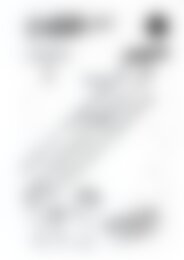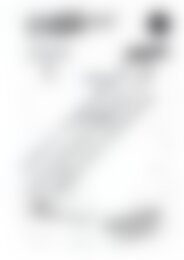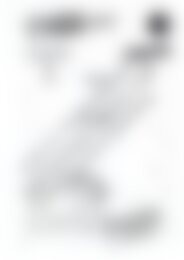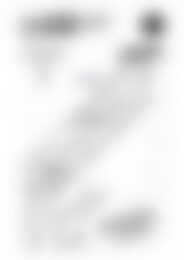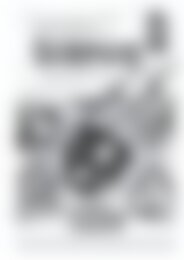RIC-6835 Maths Essentials - Geometry and Measurement 1 (Ages 11-15)
Create successful ePaper yourself
Turn your PDF publications into a flip-book with our unique Google optimized e-Paper software.
Equivalent measures<br />
Capacity<br />
Length<br />
1 000 000 cm 3 = 1 m 3<br />
10 mm = 1 cm<br />
100 cm = 1 m<br />
1000 m = 1 km<br />
Time<br />
Area<br />
100 mm 2 = 1 cm 2<br />
10 000 cm 2 = 1 m 2<br />
10 000 m 2 = 1 ha<br />
100 ha = 1 km 2<br />
Mass<br />
1000 mg = 1 g<br />
1000 g = 1 kg<br />
1000 kg = 1 t<br />
Volume<br />
1000 mm 3 = 1 cm 3<br />
Angles of elevation<br />
The angle of elevation is the angle ray AB<br />
makes with the horizontal.<br />
Angles of depression<br />
The angle of depression is the angle ray CD<br />
makes with the horizontal.<br />
Trigonometric ratios<br />
How to choose a trigonometric ratio:<br />
For right angled triangles:<br />
θ<br />
Hypotenuse<br />
Adjacent<br />
Opposite<br />
1. Label each side of the triangle with O, A <strong>and</strong> H.<br />
2. Decide which two sides are part of the problem.<br />
3. Use: SOH sin θ = O<br />
H or<br />
CAH cos θ = A<br />
H or<br />
O<br />
TOA tan θ =<br />
A<br />
to solve the problem.<br />
<strong>Measurement</strong><br />
<strong>Measurement</strong><br />
1000 mL = 1 L<br />
1000 L = 1 kL<br />
60 seconds = 1 minute<br />
60 minutes = 1 hour<br />
24 hours = 1 day<br />
7 days = 1 week<br />
14 days = 1 fortnight<br />
28–31 days = 1 month<br />
~ 52 weeks = 1 year<br />
12 months = 1 year<br />
365 days = 1 year<br />
366 days = 1 leap year<br />
10 years = 1 decade<br />
100 years = 1 century<br />
1000 years = 1 millennium<br />
Unknown side<br />
Label it with a pronumeral (x) <strong>and</strong><br />
calculate.<br />
<strong>15</strong>º<br />
x mm (H)<br />
For example:<br />
20<br />
sin <strong>15</strong>° = x<br />
20<br />
x = sin <strong>15</strong>°<br />
x = 77.3 mm<br />
20 mm<br />
(O)<br />
Decimal measures<br />
Decimal measures<br />
<strong>Measurement</strong>s should be written in decimal<br />
form where possible.<br />
For example:<br />
10 cm, 3 mm 10.3 cm<br />
2 m, 7 cm, 5 mm 2.075 m<br />
3 km, 408 m, 52 cm 3.40852 km<br />
6 L, 430 mL 6.430 L<br />
<strong>15</strong> kL, 675 L <strong>15</strong>.675 kL<br />
12 g, 325 mg 12.325 g<br />
4 kg, 75 g 4.075 kg<br />
5 t, 620 kg 5.620 t<br />
Temperature<br />
A thermometer is used to measure<br />
temperature.<br />
Freezing<br />
point of<br />
water:<br />
0 °C<br />
Measuring tools<br />
Various tools are used to measure in<br />
different situations. For example:<br />
length<br />
mass<br />
capacity<br />
Unknown angle<br />
Choose the trigonometric ratio<br />
using the steps shown <strong>and</strong> calculate.<br />
For example:<br />
θº<br />
2<strong>15</strong> cm (A)<br />
Boiling<br />
point of<br />
water:<br />
100 °C<br />
ruler<br />
tape measure<br />
trundle wheel<br />
balance<br />
kitchen scales<br />
bathroom scales<br />
measuring spoons<br />
measuring cups<br />
measuring jugs<br />
graduated cylinders<br />
tan θ = O A<br />
84<br />
= 2<strong>15</strong><br />
θ = tan ( 2<strong>15</strong>)<br />
–1 84<br />
θ = 21.3°<br />
84 cm<br />
(O)<br />
2-D shapes<br />
2-D shapes have two dimensions—width <strong>and</strong> length.<br />
They may have curved or straight sides.<br />
Shapes with straight sides are called<br />
‘polygons’. Polygons have three or more<br />
sides <strong>and</strong> angles.<br />
Polygons with sides of an equal length <strong>and</strong><br />
angles of an equal size are called regular<br />
polygons.<br />
Polygons with three sides are called ‘triangles’.<br />
3-D shapes<br />
Parts of a 3-D shape include:<br />
faces<br />
The surfaces of a three-dimensional fi gure.<br />
edges<br />
The intersections of two faces of a<br />
three-dimensional fi gure.<br />
vertices<br />
The intersections of three edges of a threedimensional<br />
fi gure.<br />
<strong>Geometry</strong><br />
<strong>Geometry</strong><br />
Polygons with four sides are called<br />
‘quadrilaterals’.<br />
Quadrilaterals with opposite sides parallel<br />
are called ‘parallelograms’.<br />
Other shapes include circles, semicircles <strong>and</strong><br />
ellipses.<br />
prisms<br />
If the two ends of a prism are<br />
the same size <strong>and</strong> shape; they<br />
are congruent.<br />
Nets<br />
A net is a 2-D plan which can be used to<br />
make a 3-D shape.<br />
Three-dimensional shapes are also called ‘solid figures’. A 3-D shape has length, width<br />
<strong>and</strong> height.<br />
©R.I.C. Publications<br />
Low Resolution Images<br />
Display Copy<br />
regular polyhedra<br />
The faces of these 3-D shapes are all the same shape<br />
<strong>and</strong> size. There are fi ve: tetrahedron, octahedron,<br />
hexahedron, icosahedron <strong>and</strong> dodecahedron.<br />
pyramids<br />
A pyramid is made up of a base shape such as a<br />
triangle, square, hexagon or decagon.<br />
The opposite end of the shape forms a point<br />
called an ‘apex’.<br />
Angles<br />
An angle (<br />
acute angle<br />
An angle less than 90°.<br />
right angle<br />
An angle of exactly 90°.<br />
obtuse angle<br />
An angle between<br />
90° <strong>and</strong> 180°.<br />
reflex angle<br />
An angle between<br />
180° <strong>and</strong> 360°.<br />
The four angles in a<br />
quadrilateral add up to<br />
360º.<br />
rectangle<br />
90º + 90º + 90º + 90º = 360º<br />
rhombus<br />
a + b + a + b = 360°<br />
parallelogram<br />
a + b + a + b = 360º<br />
acute<br />
angle<br />
right<br />
angle<br />
obtuse angle<br />
reflex angle<br />
straight angle<br />
An angle which is exactly<br />
180°.<br />
straight angle<br />
complementary<br />
angles<br />
Two angles which add to<br />
90° (a right angle).<br />
) is formed when two lines meet. Angles are measured in degrees.<br />
A degree ( ) is a unit of angular measure. There are 360° in one complete<br />
rotation.<br />
A protractor is a tool used to measure the size of an angle.<br />
Quadrilaterals<br />
50°<br />
40°<br />
supplementary angles<br />
Two angles which<br />
add to 180° (a<br />
straight angle).<br />
corresponding<br />
angles<br />
alternate angles<br />
co-interior<br />
angles<br />
<strong>Geometry</strong><br />
<strong>Geometry</strong><br />
50°<br />
130°<br />
vertically opposite angles<br />
Congruent angles formed when two lines<br />
intersect.<br />
Mathematical terms<br />
attribute<br />
A characteristic of an object. A<br />
way to classify objects; e.g. round,<br />
red, thick.<br />
classification<br />
Arrangement into classes<br />
(sets or groups) according to<br />
attributes.<br />
congruent<br />
Two fi gures are congruent if they<br />
are the same size <strong>and</strong> shape.<br />
coordinates<br />
A referenced point on a grid can<br />
be found using an ‘ordered pair’<br />
of numbers. These are called the<br />
coordinates of the point. The<br />
horizontal axis is always read or<br />
written before the vertical axis.<br />
line<br />
Made up of an infi nite set<br />
of points extending in both<br />
directions.<br />
line segment<br />
A line with two end points.<br />
model<br />
A representation of an object<br />
preserving the signifi cant<br />
features.<br />
net<br />
A fl at pattern that can be folded<br />
to make a three-dimensional<br />
model.<br />
network<br />
A system of lines (paths) <strong>and</strong><br />
nodes (points representing<br />
intersections).<br />
parallel lines<br />
Two or more straight lines in<br />
the same plane which will never<br />
meet. They are always the same<br />
distance apart.<br />
path<br />
A line connecting points (nodes)<br />
in a network.<br />
perpendicular lines<br />
Two lines which form right angles.<br />
plane<br />
A surface which is fl at <strong>and</strong> has no<br />
boundaries.<br />
Triangles<br />
Triangles<br />
angles in a triangle<br />
Triangles can be named according to the size<br />
of their angles.<br />
exterior angles<br />
The exterior angle<br />
of a triangle is<br />
equal to the sum of<br />
the two opposite<br />
interior angles.<br />
congruent triangles<br />
Triangles are congruent if they are identical<br />
in shape <strong>and</strong> size.<br />
Two triangles can be called congruent if:<br />
SSS: all sides the same length or<br />
SAS: two sides the same <strong>and</strong> the angle<br />
between those sides the same or<br />
ASA: two angles the same <strong>and</strong> the side<br />
between those angles the same length<br />
or<br />
RHS: If the hypotenuse <strong>and</strong> a side of one<br />
triangle are respectively equal to the<br />
hypotenuse <strong>and</strong> a side of the other<br />
triangle, then the two right triangles<br />
are congruent.<br />
ray<br />
Made up of an infi nite set of<br />
points emanating from a point<br />
<strong>and</strong> going in one direction.<br />
scale<br />
The ratio of measurements<br />
of a model or diagram to<br />
corresponding measurements of<br />
an enlarged or reduced version.<br />
section<br />
A fl at surface made by cutting<br />
through a solid in any direction.<br />
similar<br />
Two shapes are similar when<br />
they have the same shape but are<br />
different in size.<br />
tessellation<br />
A repeating pattern of congruent<br />
shapes that completely cover an<br />
area leaving no gaps or overlaps.<br />
traversable<br />
A network is traversable if all<br />
paths can be traced over without<br />
going over the same path twice.<br />
<strong>Maths</strong><br />
No part of this publication may be reproduced in any form or<br />
by any means, electronic or mechanical, including photocopying<br />
or recording, or by any information storage <strong>and</strong> retrieval<br />
system, without written permission from the publisher.<br />
<strong>RIC</strong>–<strong>6835</strong><br />
Copyright Information<br />
9!BMFBI






